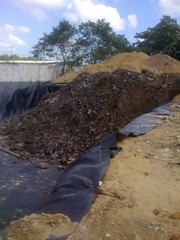
Capping and sealing low-level waste
A commission overseeing low-level radioactive waste disposal in Texas voted Saturday to publish proposed rules that would guide the importation of nuclear waste from across the country for burial near the New Mexico line.
The Texas Low-Level Radioactive Waste Disposal Compact Commission voted 5-2 to publish revised rules that would guide the importation of nuclear waste from across the country for burial in Andrews County, Texas near the New Mexico line. The proposed rules, once published in the Texas Registry, will allow for a 30-day comment period.
The vote took place without any public input. In fact, when Public Citizen’s Texas office director, Tom “Smitty” Smith tried to speak he was told he was out of order and asked to sit down. Much later, he was allowed to give comment, but the deed had already been done.
Bob Gregory, who voted against publishing the rules now, said he wanted a longer comment period and felt the commission was rushing and that there were far too many questions remaining. However, Commission Chairman Michael Ford disagreed. The vote included two Texas commissioners voting not to publish the new rule at this time, while three Texas commissioners and two Vermont commissioners voted to push the process forward.
If the proposed rules are adopted, low-level radioactive waste from 36 other states will be dumped in a remote region of West Texas along with waste from Texas and Vermont, which make up the compact. Requests for importation would be considered on a case-by-case basis.
The rules were expected to be posted in the Texas Register within a couple of weeks. The comment period begins then.
In the meantime, Waste Control Specialists (a Dallas based corporation), which operates the facility, has yet to receive final approval from the Texas Commission on Environmental Quality (TCEQ) for construction of the disposal site. There is quite a bit of controversy over the company’s license to dispose of low-level nuclear waste that was approved last year over the objections of TCEQ staff.
The commission meeting announced the day after the election and held this Saturday was its first since withdrawing an initial set of proposed rules in June to add amendments and revisions.
Gregory presented several motions seeking additional language in the proposed rules. One of his concerns was that the legislatures of Texas and Vermont, which convene in January, would want to weigh in on the proposed rules.
Tom “Smitty” Smith of Public Citizen’s Texas office said amending the rules once they’re adopted hasn’t worked in other instances he’s seen.
If approved, WCS tells everyone that the new disposal site would start taking worker clothing, glass, metal and other low-level materials currently stored at nuclear power plants, hospitals, universities and research labs. But this is deceptive because the so-called “low-level” radioactive waste includes every radioactive element. In fact, radioactive elements that are high-level nuclear waste become “low-level” when they leak out of the irradiated fuel rod cladding. So, plutonium, cesium, strontium, iodines, and hundreds of other radionuclides that are “high-level” become “lowlevel” simply by escaping from the irradiated fuel. Thus, both high- and “low”-level nuclear power wastes are hazardous for literally millions of years. This means “low-level” radioactive waste stored at the dump could also include:
- Irradiated Components and Piping reactor hardware and pipes that are in continual contact with highly radioactive water for the 20 to 30 years the reactor operates;
- Control Rods from the core of nuclear power plants–rods that regulate and stop the nuclear reactions in the reactor core;
- Poison Curtains which absorb neutrons from the water in the reactor core and irradiated fuel (high level waste) pool;
- Resins, Sludges, Filters and Evaporator Bottoms from cleansing the water that circulates around the irradiated fuel in the reactor vessel and in the fuel pool, which holds the irradiated fuel when it is removed from the core; and
- Entire Nuclear Power Plants if and when they are dismantled. This includes, for example, from a typical 1,000 megawatt nuclear reactor building floor: over 13,000 tons of contaminated concrete and over 1,400 tons of contaminated reinforcing steel bar.
In the early 1980s, the federal government started urging states to build low-level nuclear waste landfills, either on their own or in cooperation with other states in compact systems.
South Carolina entered into a compact with New Jersey and Connecticut, agreeing to dispose of nuclear waste at a landfill that later accepted waste from dozens of other states until ten years ago, when South Carolina lawmakers said they no longer wanted the state to be a national dumping ground. And in 2008, the facility started accepting waste from only its compact partners, leading other states to look to Texas to store their waste.
There could be more nuclear waste in need of a resting place if President Barack Obama moves ahead with his plan to build dozens of new nuclear facilities.
Environmentalists are largely worried about toxins from the Texas site leaking into groundwater beneath the scrub brush land that’s brought oil prosperity to arid West Texas for nearly a century. One of the issues at stake here is whether the landfill sits over the Ogallala Aquifer that underlies eight states that constitute 25% of the nation’s agricultural land. USGS maps show the dump site sitting over the southern end of the aquifer, but when the permitting process started, the Texas Water Develpment Board reissued maps that showed the site no longer sat over part of the Ogallala Aquifer.
Public Citizen will keep you apprised of when the rule is published and we encourage anyone and everyone who is concerned about this to submit comments. We will provide you with the information on how to do this once the rule is published.
###
By promoting cleaner energy, cleaner government, and cleaner air for all Texans, we hope to provide for a healthy place to live and prosper. We are Public Citizen Texas.


